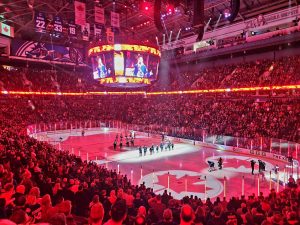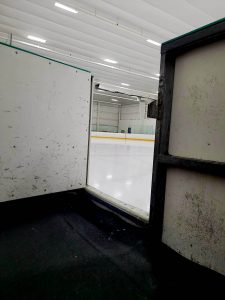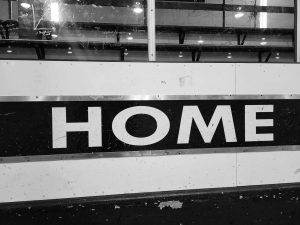
Massimo Felicella
Massimo Felicella is in the final year of his Bachelor of Interdisciplinary Studies at Capilano University. His journey began at some time ago but he is immensely proud of the person he has become. In the future, he hopes to continue to pursue his goal of coaching at the highest level possible.
I would first like to acknowledge the difficulty in creating this piece and finding participants willing to step forward to share their thoughts. As players and as coaches, I respect there is a brand image to protect and at times the greater picture can affect the finite details. The purpose of the following is not to create divide but simply bring light to a problem that has long existed in the game of hockey. When reading excerpts from others, please keep in mind they may not agree with everything I bring forward but rather took an opportunity to share and include their perspective; everyone’s opinions are their own.
–
I vividly remember being glued in front of my television on a Saturday night sitting on the rough hardwood floor staring up at the static screen. I still hear my mother frequently reminding me to sit further back to avoid damage to my eyes as she made dinner from the kitchen. It was one of those TVs where you had to turn the dial, and on Saturday nights, no one was allowed to touch it but me: the Leafs were playing on Hockey Night in Canada. While watching the likes of Mats Sundin, Tie Domi, and Ed Belfour dance around on the screen, I wanted to be just like them – I wanted to be a hockey superstar. I remember asking my parents for several years to play, but it never materialized into anything beyond talks at the dinner table or letters to Santa. Then, the day finally came. My parents sat me down and I thought I was in trouble. They proceeded to tell me the best news of my life: I was going to be a hockey player. I could not sleep for the next few days adding to the exhaustive list of scenarios I had already imagined in my illustrious NHL career. I was eight years old and ready to conqueror the world; my dreams, or so I thought, could be a reality. This was the first of many moments in my own personal life and experiences where hockey is not always the sport I fell in love with. I fell in love with the excitement, the noise, the toughness and the entertainment. What I did not fall in love with was the drama, the politics, the toxicity of hockey culture – the ugly truth no one, let alone an eight year old boy, sees through a TV.

Hockey is Canada’s game.
To most people, the actions of Don Cherry or the recent uptake in survivors coming forward about instances with Hockey Canada is a surprise. Canadians are supposed to be welcoming, accepting, sorry-saying people, not individuals who say hurtful things, commit heinous acts or use their own standing to put down those around them. I am beyond ashamed to say to those who are involved with the sport at any in-depth level, the actions of Don Cherry and the stories from Hockey Canada are not a surprise. As eye-opening as it is, these actions seem to be “on brand” with what I would say current belief in hockey is, albeit swept under the rug. Even at the minor hockey level there is persistent use of discriminative language used game in and game out – but nothing ever changes as this type of behaviour seems to be deep-rooted into the very core of players at all levels of the game.
The NHL and their subsequent sponsors have adopted a “Hockey is for Everyone” slogan in response to the backlash the League and sport are receiving for these recent events coming into the public eye. The League is trying to do everything in their power to change the perception and acceptance of minority groups, sexual orientations and representation of lower class families in our game. This initiative has fallen far below the expectations placed before it and as a result, nothing continues to change and I struggle to see how change will ever be possible unless we target the new generations of young hockey players. Presently, hockey is not for everyone unless ‘everyone’ is a straight, white male from an affluent family because wealth, race and sexual orientation are the gatekeepers of success in the sport of hockey. Although this may not be explicitly clear at the grass roots levels with demographic differences in the Fraser Valley, once entering into pro-level leagues, the disparity is staggering. What follows will feature personal experiences, interviews from players at various levels of hockey including professional as well as grass roots levels and supported research to showcase how imbedded these toxic traits are to the game of hockey.

Hockey is intensity.
Hockey is a status symbol on and off the ice: from the gear you wear to the team you play on. Wearing used, broken down, old equipment is like chumming the water for a shiver of sharks; blood is in the water and blood is what they come for. Insults are hurled at kids nonstop for the type of equipment they use; I experienced it and I see it as a coach. Fewer and fewer kids are playing hockey simply because they are being bullied out of the game by those children who are affluent who create culture that you need to have the best equipment to play or else you do not belong. Another despairing factor is how expensive the sport is to play. In Minor Hockey, recreational (non-Rep) costs are roughly $800 – $1,100 per season simply to play the game. The cost of equipment is roughly another $1,000 – $1,500 in up front requirements. Kids also grow, and fast. There is often a need for constant changing of equipment especially in that early age of playing. As players make higher and higher levels, the cost to play exponentially increases. For example, my team this year has a per player cost of approximately $2,400 and could have been more. Above my team, there are “zone” based teams where the best of the best play. Their current season cost is roughly: $17,000 – and no, it is not a typo. Not all parents can pay this and not all parents want to pay this, and remember this is per child; families with multiple children have to far tougher time. As a result, hockey is creating it’s own culture forcing less fortunate children into recreational leagues simply because of the cost to play. This results in exclusivity to the higher leagues in hockey of only affluent families. Of the leagues and of these players, the players whose parents have paid more are the ones going to the higher levels reinforcing if you do not have money, you do not belong in hockey.
I cannot, even for a moment, fully understand the trails and hardships experienced by those facing real racial or sexual orientation issues. What I can speak to, though, is my experiences coming from an under-privileged family, at least to not put an exuberant burden on my parents to play the sport I love. I had asked to play hockey for years but I was never told why. My father worked hard, often leaving for weeks at a time for his job as a long-haul truck driver meaning my mother had to stay home to take care of her three children resulting in a single income. My parents lived paycheque to paycheque, struggling to keep up with the demands of having three kids, costs of living. Finally, I was able to play; I would not have new or expensive equipment but I would be playing. Sadly there were rumblings, there was judgment, and there was ridicule from other parents who were able to take on these extra costs. They treated my parents poorly, and naturally, their children saw this behaviour and I became a target, bullied because my parents struggled financially – and only got worse as I got older. It made me want to quit and I even did for one year until I realized how important hockey was to me and I have regretted it ever since. The sport I devoted to every Saturday night, early mornings, hard losses, triumphant wins and learning experiences to became the source of my ridicule.
“The first thing they say to me is, “Mr. O’Ree, I can’t imagine what you had to go through to make it possible for players like me to play in the League.” And, yeah, it was hard. Besides being black and being blind in one eye, I was faced with four other things: racism, prejudice, bigotry and ignorance. There wasn’t a game that went by that I didn’t hear racial remarks and racial slurs. Not only from players on the opposition, but fans in the stands” (Willie O’Ree, NHL.com, 2019).
Hockey, historically, has always been vastly white. Willie O’Ree was the first African American man to play in the NHL in 1958. The next person of colour to play in the NHL was not until 1974. Since 1917, two African Americans have played in the league in fifty seven years. There have been others: Larry Kwong in 1948 became the first Asian player to play an NHL game and in the mid 1950’s Fred Saskamoose became the first Canadian First Nations player to crack the league. Outside these first milestones, the list of ethnic players in the history of the league pales in comparison to the percentages of white players. Up to 2017, approximately 87 players entered the NHL identifying as African American, 26 as Asian and 30 as First Nations. It is of the utmost importance to keep in mind these figures may not be to the number exact as records over time are lost, and there certainly have been players who hid their identity to not put themselves at risk. In a statistic provided by the NHL 7,623 players have completed an NHL game since the League was created meaning roughly 0.01% were African American, 0.003% were Asian and 0.004% are First Nations (NHL.com, 2017). One thing I can assure you: it was not because they were any less skilled. The old ways of hockey created these racial blockades.
There has been countless documentation of racial interactions occurring at all levels of pro hockey. Recently, Akim Aliu has come forward to share his story. Coaches, players, team managers – seemingly everyone, were willing and able to be racially charged towards Akim with no recourse. On several instances he claimed his direct coaches referred to him using derogatory slurs, and he had to go along with it or he risked his career. The issue with racism in pro leagues is power and advancement is controlled by older, white men who grew up in times where their racism was accepted. Those who speak up or give push back of any kind are thrown to the outskirts with their careers in jeopardy. Akim and countless other players have been forced to lose their voice and accept this behaviour if they had any hope of playing in the NHL or other pro leagues. Players of colour and different ethnic backgrounds are taught from a young age to accept racial slurs, the way they are treated have no voice. The players who do not accept these commandments are punished with their careers being thrown into the abyss like Akim.

Hockey is opportunity.
Even more unfathomable is in the entire 107 year history of the NHL, there has been a single player to self-identify as LGBTQ under an NHL contract. Luke Prokop openly came out as gay in 2021 sending waves throughout hockey. Having followed his journey and some players on his team who I have the pleasure to know and coach, Luke was a part of that dressing room even more than before and those players ought to be role models for the remaining hockey players. One thing is clear from Luke coming forward: it does not matter who you are, where you come from, what you believe in. You are you, and we are here to achieve a common goal. Your role and your impact is wanted, regardless of race or sexual orientation.
Some NHL teams in the past few months have had their Pride night to celebrate LGBTQ+ communities and to show a welcoming and willing environment for those who identity under these branches. Sadly, two NHL teams abandoned their pre-game ceremony altogether because the players could not unanimously support the initiative. Instead of carrying forward, the teams opted to protect the individuals who had different views and it was a massive blow to these communities and fans of these teams, but you can bet some people were happy. Moreover, four NHL players: James Reimer, Ivan Provorov and the Staal brothers decided to miss their team’s warm-up because their religious views did not support the decision. Their religion was used as a scapegoat to avoid putting on a jersey for fifteen minutes to show solidarity and unwavered support for these groups – to show them they are welcome here. They are welcome in the sport that has pushed them away, they are welcome in the sport the historically has not been accepting of their orientation, they are welcome and valued like every other person. I am hard pressed to believe putting on a jersey that features a few rainbows really goes against any religious values and alters a grown man’s perception and image. Frame it how ever you like, it is not a good look and undermines everything that has been done to make the game more inclusive. This and this alone proves NHL players do not unanimously believe “Hockey is for Everyone” they themselves are not willing, even for fifteen minutes, to show support for a minority group.

Hockey is together.
I sat down and posed questions to someone I coach with, players I have coached and a pro-level hockey player to see how deep-rooted these issues are and what, if anything, can be done to continue to push the game of hockey towards acceptance for all.
When discussing hockey culture and the notion ‘Hockey is for Everyone’ my Assistant Coach, Spencer Beattie, discussed how disgusting words are tossed around casually, players bully each other – the more it occurs, the more it becomes ingrained into who they are. It becomes increasingly accepted in the game as they progress to the point where the actions of the Hockey Canada players or people like Don Cherry are left puzzled as to why their actions received the reaction they did. Spencer makes clear old hockey “society has reflected patterns of racial discrimination; this combined with the elitist nature of the sport has made it less common to see minority players at pro levels. Fortunately society is moving in a more inclusive direction which is then being reflected in our game at all levels.” This type of behaviour in hockey is excused or even encouraged in some circles. People who make these kinds of mistakes downplay the significance of it because it is “just how hockey is” – no one expects them to act otherwise. Spencer shared, “There is a certain status with hockey players. My friend is playing is the middle of nowhere and he is a celebrity. It makes you feel above the law sometimes, and it is how stuff happens.” Having no recourse and immunity for actions removes the guilt. Hockey is Canada’s game and any sort of pro-level hockey player is seen as a demi-god, and a well respected, upstanding person. He also felt, “The hockey world hierarchy within a team is often based on skill and physical toughness; this hierarchy is the framework for the dynamics within a locker room between players.” Players who fail to exhibit and uphold these types of values are seen as outcasts in the locker room. At times players become afraid to express who they really are, when they are injured, show emotion, and to be struggling with something. Players who are outcasts feel they do not belong, and if they do not belong they frequently quit and stop playing hockey. Something that seems small or minute can have large scale consequences. Players rarely understand the larger part of their actions beyond making a joke, or perceivably having a little fun in the dressing room. Spencer reflects:
“Although the dynamics in the dressing room encourage values like family and brotherhood, when I reflect back on the various teams I played on there was often bullying of some sort taking place. This usually came in the form of ‘harmless chirping’ that sometimes may have sounded more like verbal assault to someone outside of the team than it did friendly banter. I would consider this a barrier for many because although it did not directly affect me, I can understand how this dynamic can be perceived as bullying at times and create a very real barrier for many that ultimately may leave individuals disliking the game.”
When asked how can we move forward to continue to grow the game and begin to alter perceptions and culture, Spencer agreed, “Hockey Canada and those involved must be held accountable” but represents a double-edged sword as “it would benefit the culture immensely to continue to grow the number of players and diversities involved in the game.” Hockey Canada does indeed do a lot to grow the game of hockey at a grassroots level. Spencer and many others stand by the onus is on Hockey Canada to not only correct their behaviour but begin to create and support initiatives that affect hockey on a greater whole. Rather than focusing on corrective approaches, the aim should be on teaching and instilling proper values to prevent any negativity being present from the start.
I spent some time speaking with my players and in the interest of protecting them as minors but also respecting their opinions I have grouped them together under a single anonymous contributor named John. These players are the ones involved in the game and hockey will be a big part of some of their lives for the considerable future; it is vital to have the perspective of future contributing members of society. John revealed: “I believe the toxicity starts at the bottom, even the smallest things, offside jokes, etc. Within our own room this year there were countless discriminatory remarks or jokes and while they may not be directed at anyone, they still contribute to the stigma that hockey culture has.” We can see yet another example of meaningless ‘jokes’ or players think they are having fun not truly understanding the greater picture. The issue here is players think this type of behaviour is okay, and it desperately needs to change before it turns into targeted words and learned behaviour as they progress. The players know it is not okay or else they would have no issues in acting this way when the coaching staff or other adults were around. It has become cool and status quo to use these remarks – jokingly or otherwise; this is not acceptable. John also spoke about how, “The stigma around the culture of hockey is not great; sexist, racist, homophobic, anything you can think of, hockey has been called. This could make many people feel uncomfortable about getting into, or continuing with the sport.” Along with the barriers hockey puts up with regards to money, players are constantly presented with attacks to who they are as people.
Unanimously, everyone I spoke with affirmed, “Hockey culture is trending in the right direction, (more inclusivity and acceptance), which will open doors to people who felt uncomfortable about the sport before, but it is unclear about how we will address the affordability of hockey.” Of all the conversations, the players felt it was on themselves as leaders and individuals to learn and grow with help from their coaches.
Lastly, I reached out to Luke Prokop on Twitter. I asked him if I could pose him a few questions and he agreed to share his perspective. Luke has been a beacon of acceptance and change within the NHL. Through his continued work, statements and press releases, he inspires the next generation of hockey players while encouraging acceptance and participation at the NHL level. Most recently, Luke released a statement in regards to the debacle of teams and players forgoing Pride night echoing what he shared with me:
“Pride nights are an essential step towards fostering greater acceptance and understanding in hockey, and I strongly believe that by prioritizing diversity and inclusion, we can create an environment where every player feels comfortable bringing their authentic selves to the game. As someone who aspires to play on an NHL team one day, I would want to enter the locker room knowing I can share all parts of my identity with my teammates… While there is still progress to be made before hockey is for everyone, I’m optimistic about the change we can achieve and am committed to being a part of it”.
Luke’s statement features more than what is included above and I encourage everyone to read the full length as well as view his sit down with Sportsnet to gain a deeper understanding of what these nights mean to the community, what these moments mean to Luke and how we can move forward – together. Luke shared one of his biggest inspirations for stepping forward was because “I want to help be a role model, I want kids to watch hockey, look at the TV [and think]: ‘he is like me, I can do this’”. There are not many figures younger players can draw inspiration and courage from but Luke is certainly one of those people. Since showing the rest of the world his true self Luke added, “My social media platforms have grown a lot since, so I get to chat with more people in the community who have questions. Other than that nothing really has changed at the rink, with my teammates or in the locker room.” He notes the tremendous outpouring of support from his friends and family even more so with the uncertainty of coming forward given the climate and acceptance in the NHL. In an article from Sportsnet a few weeks ago Luke’s father, Al, shares, “One of my fears, to be brutally honest, was: you’re a drafted player, you’re on the right track, is something like this going to impact you negatively as you try to pursue your dream…are you going to get the chance to pursue your dream as fairly as somebody else?” To have to wonder if you are given equal opportunity in the sport of hockey because of your sexual orientation is surely a despairing thing to ponder. As Luke points out in his statements and response to my questions, though, him coming forward has resulted in not being afraid to be who is truly is and being treated the same way by his teammates if not better. This offers glimpses of hope the game of hockey is changing and beginning to pave the way to being inclusive and welcoming for all. For Luke and countless others, “hockey is my passion, my first love and always will be”.

Hockey is home.
A continuous theme in the conversations I have had and the research I conducted was: the game of hockey needs to evolve at the grass roots level. As new generations begin to make their way through the ranks of hockey, they can start to facilitate a change in culture and a change in mentality. Without change “damaging behaviours continue [to be] reinforced at rinks and inside locker rooms – including recklessness, violence, a glorification of pain, pernicious power dynamics and narrow notions of masculinity. They are destructive ways of being that recur in some athletes’ encounters out in the world” (Bielski, 2022). Locker room talk continues to “serve as a bonding exercise. Among the rest, nobody spoke up beyond the odd, ‘Ah, dude, gross, too far’” (Bielski, 2022).
I firmly believe coaches and parents have a larger role to play in becoming role model for these players. As a coach, I strive to create an open environment where players are able to express themselves in their own way, everyone has their own unique voice and I am genuinely invested in their development as people. I take it personally to mentor and develop eighteen teenagers as they grow into their future selves. Without question “hockey coaches in particular have the power to set a positive tone with adolescent and teenage athletes… old guard coaches [still exist] who might encourage hits, fights, playing through an injury or ‘manning up’ – that your feelings, emotions, experiences do not matter” but this cannot be the way we continue to coach in hockey (Bielski, 2022). All this is doing is creating and deepening the culture from a young age. As players progress, these feelings are pushed further down and expectations players push through exponentially increased. Real change is “moving upstream to get them to care and think differently about what it is to be a man, have a healthy relationship and think about mental health and well-being in the settings we embed ourselves in” (Bielski, 2022). Old coaching is taking the easy way out, letting this culture exist and continue to infect hockey; new coaching is understanding the human aspect, putting the sport aside enough to understand when the skates are hung up for the last time, these are still impressionable and valuable young people who have to live the rest of their lives. We need to do away with the “unethical conduct among the boys, it is a hyper-masculine sport culture that sustains and maintains rules that rely on and ensure silence and fear among boys and men” (Kehler & Knott-Fayle, 2022). There needs to be further awareness and encouragement of open, honest dialogue between players, coaches and parents. Core values need to be instilled in these players to show it is okay to come forward with issues, to be injured, and most importantly, to be unique as one’s true self.
Hockey Canada is the crux of moving forward. While responsible for hiding, downplaying and outright denying any issues with culture, they impact the lives of so many young Canadians playing across the country. Hockey Canada ought to be held responsible to “change the instructions, guidelines and institutional culture that uphold and maintain damaging versions of masculinity. With purposeful change and intentional redirection, Hockey Canada can lead a culture shift within sport” (Kehler & Knott-Fayle, 2022). Hockey, for Canadians, has become infused to the inner workings of who we are as people; it was come to represent so many of our lives, and our identity. Hockey “is the most unimpeachable brand in the country…but it has been inherently secretive because so many Canadians have a personal stake in the game. It takes all the virtues and adopts it to the mantle and functions of what it means to be playing hockey” (Eitizaz, 2022). Until recently, most Canadians thought this brand represented hope, unity and patriotism. Hockey Canada has a long way to go to repair the relationships it has damaged with hockey players and Canadians but I am confident they can change their narrative to push for change.
Young athletes represent the future: future of the game and future of change. Tangible change must occur at the local and Minor Hockey level to instill better core values and beliefs in the young men that will inevitably grow into contributing members of society. While there is value and benefit to attacking the processes from the top down, the radical change in thinking cannot occur unless these values are imprinted in young athletes. Somewhere down the line, toxic hockey culture spreads like a parasite forever altering their lives. By having these conversations, by listening to the players who are beginning to shape their own lives and future, we can best plan for the best change. Change is not going to happen today, tomorrow or perhaps not for a while but this is a battle worth fighting. Having players like Luke not afraid to step forward and share their story act as inspiration and begins to plants the seed of change so when the next eight year old falls in love with hockey, all that exists is a welcoming and inclusive sport. When I interact with my own team and guide them to be better people and players, I can only hope to be a part of positive change that influences the improvement of hockey culture and truly make hockey for everyone.
References
Burke, A., Cochrane, D., & Ricci, T. (2022). Hockey Canada Scandal : A Culture of Impunity. Canadian Broadcasting Corporation.
Bielski, Z. (2022, December 6). HOCKEY LOVERS AIM TO HELP YOUNG MEN IN THE SPORT BE BETTER; As the sport’s toxic culture faces a reckoning, Zosia Bielski speaks with coaches, parents and researchers about why change has been slow and how to move forward. Globe & Mail (Toronto, Canada).
Eitizaz, S. (2022, October 7). The Hockey Canada scandal and the culture of sport. The Toronto Star (Toronto, Ontario).
Kehler, M., & Knott-Fayle, G. (2022, November 12). Hockey Canada scandal highlights toxic masculinity in sports. Globe & Mail (Toronto, Canada).
Moore, Evan. (2021). Game Misconduct: Hockey’s Toxic Culture and How to Fix It. Triumph Books
NHL.com, & O’Ree, W. (2019, February 1). Black history month ‘has always been special to me,’ says O’Ree. NHL.com. Retrieved from https://www.nhl.com/news/willie-oree-essay-black-history-month/c-304330180
NHL.com, & Relations, N. H. L. P. (2017, September 27). NHL offers online access to 100 years of player, Team, Game Stats. NHL.com. Retrieved from https://www.nhl.com/news/nhl-historical-stats-press-release/c-291394420
Sportsnet, (2023, March 21). Predators prospect Luke Prokop ‘disappointed’ by NHL’s Pride Night Jersey Snubs. Sportsnet.ca. Retrieved from https://www.sportsnet.ca/nhl/article/predators-prospect-luke-prokop-disappointed-by-nhls-pride-night-jersey-snubs/
